It’s Week 4 of the Essex Coastal Challenge and we’re at the North East corner of Essex, exploring the unique Naze headland and its fascinating geology before finishing at the picturesque Stour Estuary.
Welcome to the story of Essex’s beautiful coast. It’s the last stretch of our journey and we’re ending on a high. We’ll explore the outstanding and internationally important Naze, travel to beautiful Hamford Water, teeming with coastal wildlife, and finally arrive at the Stour Estuary, made famous through John Constable’s landscapes. We agree with him: the area is the perfect subject for an oil painting.

We ended last week at the expansive Colne Point with its incredible views, right at the bottom tip of the Tendring Peninsula. From here, we travel through the Land of the Holidaymakers, enjoying the glorious British seaside. Pass through the beach towns and communities of Jaywick, Clacton-on-Sea, Holland-on-Sea and Frinton-on-Sea; countless characterful wooden beach huts and caravans; and a few links golf courses, plenty of amusements, and cafés along a mostly paved path that edges miles of sandy beach.
Keep hold of your bucket and spade when you reach our first destination: Walton-on-the-Naze. Like Clacton, the town made a name for itself as a late-Victorian resort hotspot with a pier. Pass through the town to the impressive Red crag and London clay cliffs. These are some of the few cliffs along the Essex coastline, and sitting at the very top you’ll find one of Essex Wildlife Trust’s newest Nature Discovery Centres.
The Naze [1]
The Naze Nature Discovery Centre is located atop a unique coastal landscape of outstanding geological and biological importance. As the most easterly peninsula in Essex, it is a critical point for many migratory and breeding birds, as well as countless other species - from butterflies to barnacles. You see the section of the cliff face directly below us? It dates back 50 million years - imagine what it’s seen!
August is the perfect time to explore the beaches. Search for crabs, gobies and whelks in the clay pools of the beach. Gaze out to sea and you might spot a harbour porpoise or a seal!
From the pillboxes of the Second World War to fossilised shark teeth hidden among the stones, the surrounding beaches reveal flashes of history (a boy recently found a giant megalodon tooth here). But today our oceans and beaches have been severely affected by plastic pollution in recent decades and sadly, they desperately need our help.
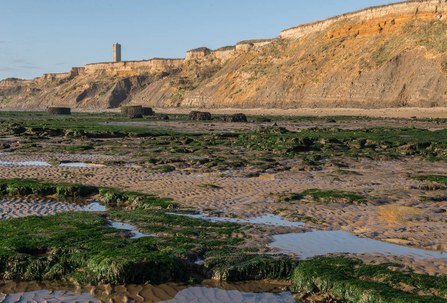
It is estimated that 12.2 million tons of plastic enter our seas every single year, trapping, injuring and entangling animals; and making its way into the food chain. Last year The Naze Nature Discovery Centre ran regular beach cleans and nurdle hunts to keep the beaches and surrounding areas clean and safe for wildlife. Take part in a beach clean near you – or do your own – and help save our seas.
Shoresearch at The Naze [2]
This final leg of the Essex Coastal Challenge would not be complete without trying our hand at a relaxing and fascinating seaside pastime: a beach survey. We don’t need to be experts to make a difference! So we’re heading to the Naze Beach, just below the Nature Discovery Centre.
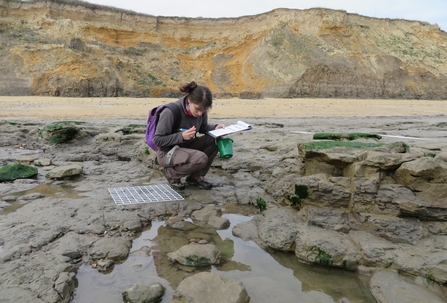
We first learned about Shoresearch over at Southend Pier back in Week 1 of the Essex Coastal Challenge. Shoresearch is The Wildlife Trusts' national citizen science survey of the intertidal shore. Volunteers are trained to record the wildlife on shores across the UK, to monitor our fragile sea life and better understand the effects of pollution, invasive alien species and climate change. This will become even more important as we navigate the climate crisis. Last year over 120 volunteers took part in nine surveys in six locations, including at The Naze. Species to look out for today include common whelks, wracks, sea chervil and hornwrack. If we’re lucky, we may even find a beautiful beadlet anemone with its tentacles extended – searching for prey!
John Weston nature reserve [3]
It’s difficult to tell where sea ends and land begins now, as we reach a huge basin of water that forms a special part of the Essex coast. Walton Channel separates the headland from Horsey Island, which provides tidal protection for the fragile backwaters of Hamford Water. Hamford Water is another one of Essex’s precious National Nature Reserves: unsurprisingly, it was the setting for Arthur Ransome’s book The Secret Water. Suddenly, beach huts, caravans and sandcastles feel a world away. Stop to take in the unspoilt solitude and peace that nature provides. These views have changed very little for many years: look out over farmland to one side and creeks on the other, teeming with wildlife.
John Weston nature reserve, behind the sea wall, is Council-owned and managed by Essex Wildlife Trust. It is designated as a Site of Special Scientific Interest. The nature reserve is located far enough from the main hub at The Naze to be a secluded gem for wildlife, while still allowing public access to certain areas for us to enjoy. There is an area of grazed grassland where scrapes and ponds have been created to provide resting places for passing migratory birds. Plans to create areas that hold water throughout the year will provide valuable habitat for overwintering and nesting waders.
Walk along the looped path - most of the habitat here is rotationally cut scrub, which creates a mosaic of different aged blackthorn, hawthorn and bramble areas, perfect for small birds, insects and small mammals. These areas are cut with the help of volunteer work parties. Having been left to grow during the spring, the small meadow was cut for hay last month; it will now be grazed with sheep to keep it short for wintering birds. Look up and see nesting boxes for majestic barn owls.
Continue your exploration of Hamford Water and cast your gaze from the sea wall towards Skipper’s Island.
Skipper’s Island nature reserve [4]
Skipper’s Island is one of Essex Wildlife Trust’s most remote and unique reserves. It has no public access and is reached by a muddy walk across the causeway at low tide or by a short boat ride. The majority of the site is saltmarsh and areas above the high tide line support rough coastal grassland and scrub. The higher areas are actually three islands joined together by a sea wall.
Crouch down in the rough grassland. Can you spot something really precious? This habitat supports an abundance of sea hogs fennel, which is a rare plant found locally on the north Essex and north Kent coasts. Sea hogs fennel is of conservation priority in its own right but is also the sole caterpillar foodplant of one of the UK’s rarest and most vulnerable moths: the Fisher’s estuarine moth. The caterpillars of this moth are stem borers and feed within the stems and then the rootstock of sea hogs fennel. Each year the abundance of the moth is monitored in July by counting the proportion of sea hogs fennel plants supporting the caterpillar’s characteristic ‘frass’ volcanoes at their base.
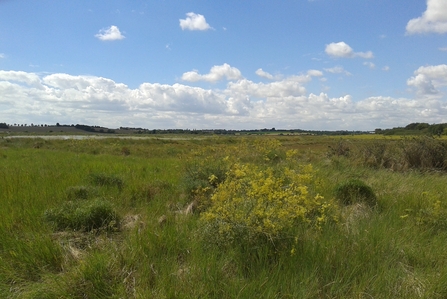
Skipper’s Island is the most important site for the moth in the UK, but it is also very vulnerable to flooding due to coastal erosion and sea level rise. This vulnerability was apparent earlier in the year when the sea wall breached, which resulted in an increase in saltmarsh but a loss of habitat for sea hogs fennel and Fisher’s estuarine moth. Thankfully, we have been preparing for this eventuality for some years and have been establishing habitat for the moth on higher ground, away from the threats of flooding, to secure the long-term future of the species in the UK.
Common Seals [5]
Now turn your gaze to the distance, out to the mudflats, and spot a much larger animal – the endearing dog-like face and plump, orange body of a common seal! This part of the world is great for spotting seals, and Essex has a rather unique variety of common seal with eye-catching orange fur - the iron oxide in the mud gives their fur this distinctive orange hue as it harmlessly attaches to them over time.
As large mammals and top predators, seals need large areas to feed, rest, breed and raise their young. We need your help to ensure that our coastal and marine habitats are protected, restored and created as part of a Nature Recovery Network that will help create a Wilder Essex. Hamford Water is a special place that must continue to be valued and its wildlife protected. Common seal pups are born during the summer and can swim when they are only a few hours old but must not expend unnecessary energy making their way to the water. If you come across a young or adult seal whilst it’s resting on the beach or a mud bank, make sure to give it plenty of space and keep pets well away to avoid spooking them.
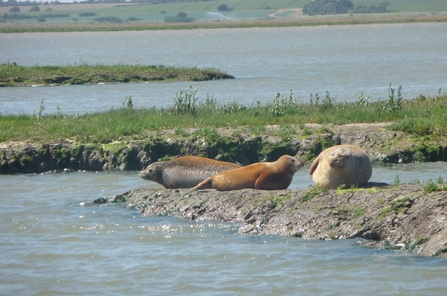
Now we head northwards. Take in the view at pretty Landermere and its quay, explore the characterful old lanes of Great Oakley, and head back onto the beach to Dovercourt and Harwich. Harwich’s famous international port is actually a couple of miles out of the old seafaring town, on the mouth of the River Stour. Travelling west past the port now, Suffolk lies on the opposite bank.
County-boundary River Stour is tidal all the way past the 16th century port of Mistley and past Manningtree, with its historic buildings and connections to the 17th century witch hunts. The Stour then continues to flow inland through the Dedham Vale Area of Outstanding Natural Beauty and stunning ‘Constable County’; but that’s for another day - our final destination is much closer: Wrabness nature reserve.
Wrabness nature reserve [6]
Rising from the grounds of an old mine depot by the River Stour, where nature has truly reclaimed the land, find Wrabness nature reserve. It’s a mosaic of scrub and young trees, making it a sanctuary for birds, voles, and insects. Explore the meadows and grassland areas, many of which are managed by grazing; and some of which have restricted access to protect the wildlife from disturbance. The selection of plants and butterflies is stunning at this time of year.
Along the edge of the site, low-lying grazing marshes are protected by the sea wall, which we can use as a viewing platform. You can see the new parcel of marshland that the Trust recently purchased through generous public donations. This was previously used for horse grazing, and it’s amazing to see what a difference three years has made without any disturbance. The Trust is planning to use this area to protect water vole habitat and plant a portion of it with sea hogs fennel to attract the Fisher’s estuarine moth, which we were lucky enough to see at Skipper’s Island. This will connect fragmented habitats in this part of the county to ensure the long-term survival of this rare Essex moth.
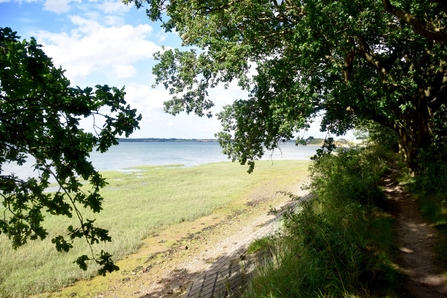
Wrabness is also home to breeding turtle doves. We have been keeping animals from a portion of the new marsh to cultivate the land for turtle doves and now, wonderfully, turtle doves are breeding on site yearly. To help keep the fields wetter for longer to attract winter waders, scrapes and ditch plugging is also planned, as has been completed on the other marsh fields that Essex Wildlife Trust owns in the same locality.
Before we say goodbye, we have some recent good news to share. Last month, it was announced that the Suffolk Coasts and Heaths Area of Outstanding Natural Beauty (AONB) has been expanded to include an extension in the Stour Estuary from Manningtree to Harwich! Not only does this showcase the North Essex coastline as a stunning landscape but we hope it will benefit our coastal environment and everyone who enjoys it for years to come.

